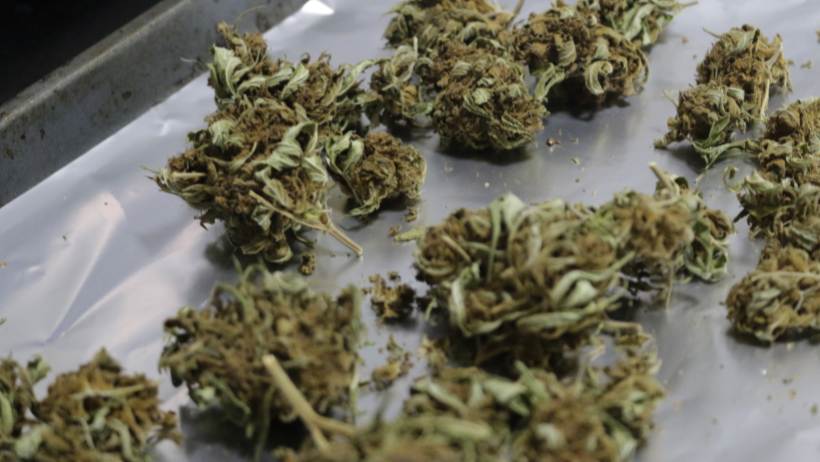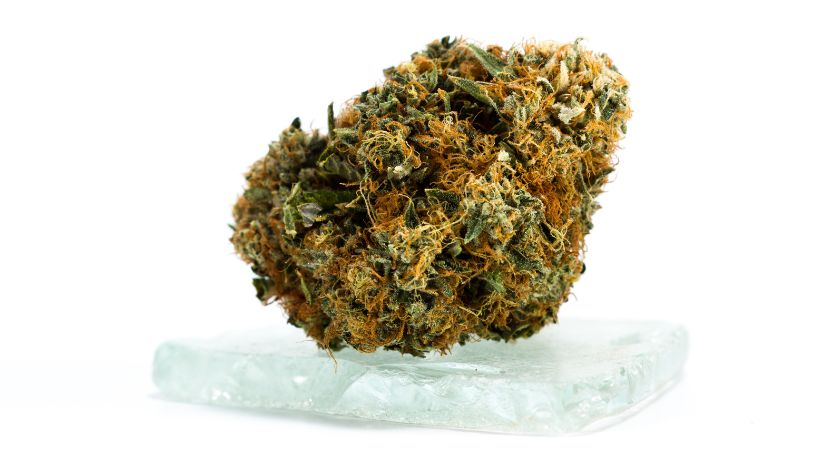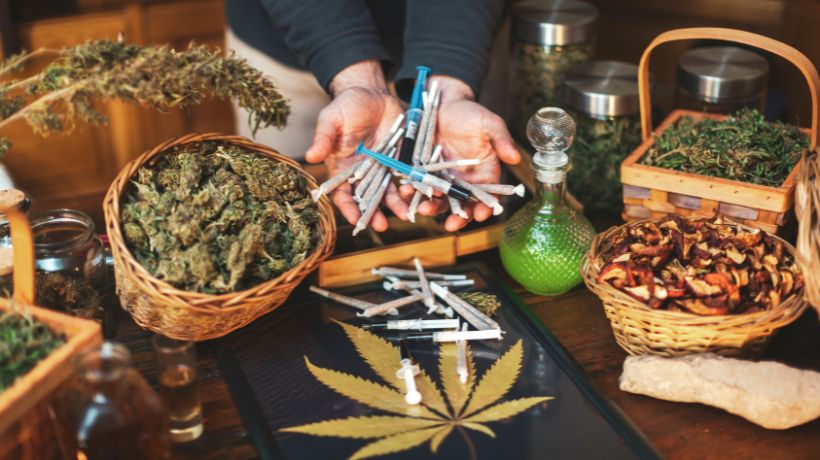Key Takeaways
- Decarboxylation transforms inactive cannabinoid acids (THCA, CBDA) into their active forms (THC, CBD), essential for potent edibles and extracts.
- Effective decarboxylation requires careful attention to temperature, time, and equipment to ensure maximum potency and safety.
- Always adhere to local cannabis laws and start with low doses when experimenting with homemade cannabis-infused products to ensure safe and legal use.
Decarboxylation is essential for anyone looking to maximize the potential of cannabis in edibles and extracts. This process activates THC and CBD, transforming these compounds into potent forms.
Understanding how to decarb cannabis properly is crucial for creating effective cannabis-infused products. It involves applying heat to activate cannabinoids, which bridges raw plant material with enhanced benefits.
This guide will demystify decarboxylation, exploring its importance, methods, and best practices. Ideal for both beginners and experienced users, mastering decarboxylation is key to improving your cannabis experience.

Introduction to Decarboxylation
Understanding Decarboxylation
Decarboxylation is a fundamental chemical process critical for anyone interested in unlocking the full therapeutic and recreational potential of cannabis.
Simply put, decarboxylation is the act of applying heat to cannabis, which transforms the inactive acidic forms of THC and CBD, known as THCA and CBDA, into their active states, THC and CBD.
This transformation is not just a chemical curiosity; it’s the key to activating the compounds that deliver the effects and benefits cannabis flower is renowned for.
Without this process, consuming cannabis plants in edibles and extracts would have minimal impact, as the body cannot efficiently utilize these cannabinoids in their acidic forms.
Understanding decarboxylation is crucial for anyone looking to explore the depth of experiences cannabis offers, ensuring that the products they create or consume deliver their intended effects.
The Role of Decarboxylation in Edibles and Extracts

Decarbing cannabis is crucial in creating potent cannabis edibles and extracts, ensuring that cannabinoids are converted to their active forms for full effect.
This process directly influences the potency and overall experience of cannabis plant products, making it essential for achieving the desired therapeutic and recreational benefits. Proper decarboxylation practices are also important for compliance with legal standards and consumer safety.
By understanding and applying correct decarboxylation techniques, individuals can safely enjoy the enhanced benefits of cannabis, aligning with legal requirements and minimizing risks.
The Science Behind Decarboxylation
Chemical Principles of Decarboxylation
The science behind decarboxylation delves into the fascinating chemical transformation that unlocks cannabis’s psychoactive and therapeutic potentials. At its core, decarboxylation involves a two-step chemical reaction [1].
Initially, heat breaks the hydrogen bonds in the cannabinoid’s acidic form, such as THCA, creating a beta-keto acid intermediate. The compound reconfigures, bonding with hydrogen again and releasing a CO2 molecule.
This critical process transforms the cannabinoid into its neutral, active form, like psychoactive THC. The application of heat accelerates the second step, making decarboxylation a pivotal process for anyone looking to access the full benefits of cannabis in its most potent form.
Factors Affecting Decarboxylation
Decarboxylation is a process influenced by several key factors, each playing a crucial role in ensuring the efficient and effective activation of cannabinoids. Understanding these factors can help optimize decarboxylation and enhance the quality of cannabis-infused products:
- Temperature: The heat must be sufficient to initiate the chemical reaction without degrading the cannabinoids. There’s a delicate balance to maintain, as too high temperatures can evaporate terpenes and cannabinoids, reducing efficacy and flavor.
- Time: The duration of heat application is critical. Insufficient time won’t fully activate the cannabinoids, while too much time can lead to degradation. Finding the optimal time ensures maximum potency without loss of quality.
- Atmosphere: The environment in which decarboxylation occurs can affect the outcome. Oxygen exposure should be minimized to prevent oxidation, which can degrade THC over time. A controlled atmosphere can preserve the integrity of the cannabinoids and terpenes.
Preparing for Decarboxylation
Selecting Cannabis for Decarboxylation

Proper preparation is key to successful decarboxylation, setting the stage for the optimal conversion of cannabinoids into their active forms. Here’s how to get started, with a focus on selecting the right type of raw cannabis:
- Strain Selection: Choose cannabis strains based on the desired effects, whether for relaxation, energy, or medical purposes. The cannabinoid profile (THC, CBD, etc.) will guide your selection.
- Quality Matters: Opt for high-quality, well-cured cannabis to ensure a better taste and more effective decarboxylation. Avoid moldy or poorly cured buds, which can affect the final product’s quality and safety.
- Plant Material: Both flower and trim can be decarboxylated, though the potency will vary. Flowers generally offer higher cannabinoid concentrations, while trim can yield satisfactory results for edibles and extracts.
By carefully selecting the right cannabis, you can significantly enhance the effectiveness and enjoyment of your edibles and extracts, ensuring a potent and desired outcome.
Equipment and Materials Needed
Before starting the decarboxylation process, gathering the right equipment and materials is essential to ensure everything goes smoothly. Here’s a list of what you’ll need:
- Oven: The central tool for decarboxylation, where controlled heat is applied to the cannabis. A reliable oven that accurately maintains the set temperature is crucial.
- Baking Sheet: A flat surface on which to spread your cannabis evenly. This ensures uniform heat exposure during decarboxylation.
- Parchment Paper: Lining your baking sheet with parchment paper prevents the cannabis from sticking to the pan and facilitates easy cleanup. It also helps distribute the heat more evenly.
- Grinder: Grinding your cannabis before decarboxylation increases the surface area exposed to heat, promoting more uniform and efficient activation of cannabinoids.
With these items prepared, you’re set to begin the decarboxylation process, taking the first step toward creating potent and effective cannabis-infused products.
Step-by-Step Guide to Decarboxylating Cannabis
Oven Decarboxylation
Here’s a detailed, step-by-step guide to decarboxylating cannabis using an oven, designed to help you achieve the best results:
- Preheat Your Oven: Begin by preheating your oven. The ideal temperature for decarboxylation is between 220°F and 245°F (104°C and 118°C). Accuracy is key, so if possible, use an oven thermometer to verify the oven’s temperature.
- Grind the Cannabis: While the oven heats up, grind your cannabis. Aim for a coarse grind, not too fine, to ensure even heat distribution without risking the small particles burning or over-decarboxylating.
- Prepare the Baking Sheet: Line your baking sheet with parchment paper. This will prevent the cannabis from sticking to the sheet and ensure an easier cleanup.
- Spread the Cannabis: Evenly spread the ground cannabis on the parchment paper-lined baking sheet. Ensure the thin layer promotes uniform heat exposure to all parts of the cannabis.
- Bake the Cannabis:
- Place the baking sheet in the preheated oven.
- Bake for about 30 to 40 minutes for cured cannabis. Freshly harvested cannabis, which contains more moisture, might require a bit longer.
- Halfway through the baking time, gently stir or shake the pan to expose all sides of the cannabis to heat evenly.
- Monitor Temperature and Time: Keeping an eye on the time and temperature is crucial. Overheating can degrade valuable cannabinoids and terpenes, reducing the quality of your final product.
- Cool Down: After the designated time, remove the baking sheet from the oven and let it cool. Your decarbed cannabis is ready for use in edibles, tinctures, or other extracts.
- Storage: If not using immediately, store the decarboxylated cannabis in an airtight container in a cool, dark place to preserve its potency.
Following these steps will help you effectively decarboxylate your cannabis, maximizing its potency and ensuring a higher quality in your cannabis-infused products.
Alternative Decarboxylation Methods
While oven cannabis decarboxylation is popular for its simplicity and effectiveness, alternative methods like sous-vide and slow cooker decarboxylation offer unique benefits and can be preferable under certain circumstances. Here’s a closer look at these methods:
Sous-vide Decarboxylation
- Grind your cannabis coarsely and place it in the vacuum-sealable bag, removing as much air as possible before sealing.
- Set your sous-vide precision cooker to 203°F (95°C) and place the sealed bag in the water bath.
- Allow the cannabis to decarboxylate for about 1.5 to 2 hours. The water temperature ensures even heat distribution and prevents the cannabis from overheating.
- After the process, carefully remove the bag and let it cool before opening.
Slow Cooker Decarboxylation
- Grind your cannabis and place it in a mason jar, loosely screwing on the lid to allow some air exchange while preventing water from getting inside.
- Fill the slow cooker with enough water to cover half the jar and set it to low heat.
- Place the jar in the slow cooker and let it sit for about 4 to 8 hours. The water bath helps distribute the heat evenly around the jar.
- Carefully remove the jar from the slow cooker and allow it to cool before opening.
Both sous-vide and slow cooker decarboxylation methods offer effective alternatives to oven decarboxylation, especially for minimizing odor or requiring a more gentle heating process.
Choosing the right method depends on equipment availability, time constraints, and personal preferences.
After Decarboxylation
Storing Decarboxylated Cannabis

After the decarboxylation process, properly storing your cannabis is essential to maintain its potency and ensure its longevity for future use.
The ideal conditions for storing decarboxylated cannabis involve keeping it in a cool, dark environment, away from any direct light sources that could degrade the cannabinoids.
An airtight container, such as a glass jar with a tight-sealing lid, is recommended to prevent air exposure and moisture from compromising the quality of the cannabis.
These storage precautions help safeguard the activated compounds within the cannabis, ensuring that they remain potent and effective when you decide to use them in your edibles and extracts.
By adhering to these storage guidelines, you can extend the shelf life of your decarboxylated cannabis, making the most out of your preparation efforts.
Using Decarboxylated Cannabis in Edibles and Extracts
Using decarboxylated cannabis in edibles and extracts offers a potent method to enjoy its benefits. Incorporating it into fats like butter or cannabis infused oils ensures even distribution in recipes, enhancing the effectiveness of cannabis across a variety of edibles.
Dosage precision is key; the final product’s potency depends on the cannabis strength and the infusion’s efficiency.
Begin with small doses and adjust as needed to achieve the desired effect, remembering that edibles have a delayed onset. This careful approach ensures a safe and enjoyable culinary cannabis experience.
Safety and Legal Considerations
Handling and Consumption Safety
Navigating safety and legal considerations is vital when dealing with decarboxylated cannabis. Ensuring safe handling and consumption practices are in place can significantly minimize risks. Always work in a clean environment to avoid contamination and use sterilized equipment.
When it comes to consumption, it’s crucial to start with low doses, especially for those new to cannabis edibles, as effects can vary widely among individuals. This cautious approach helps prevent overconsumption and ensures a safe experience.
Additionally, staying informed about local cannabis laws and regulations is essential to ensure your activities remain within legal boundaries and protect you from legal complications.
Legal Aspects of Decarboxylating Cannabis
Understanding the legal aspects to decarb weed is crucial. Compliance with local laws and regulations is essential, as they vary significantly by location.
Before beginning the decarboxylation process, it’s important to research and adhere to the specific cannabis laws in your area. This includes restrictions on possession, use, and the creation of cannabis-infused products.
Ensuring legal compliance not only protects you from potential legal issues but also supports responsible and safe cannabis use.
Conclusion
In summary, decarbed weed is crucial for unlocking cannabis’s full potential in edibles and extracts, converting THCA to THC and CBDA to CBD for maximum benefit. This guide has outlined the key steps, methods, and safety considerations for effective decarboxylation.
As you explore creating cannabis-infused products, prioritize patience, accuracy, and legal compliance. Start with modest doses to discover the ideal effect for your preferences.
Embracing decarboxylation with responsibility ensures enhanced cannabis experiences within safe and legal parameters.
Sources –
- MagicalButter UK – Edibles Made Easy. Magical Brands UK. Published 2024. Accessed March 31, 2024. https://magicalbutter.co.uk/
